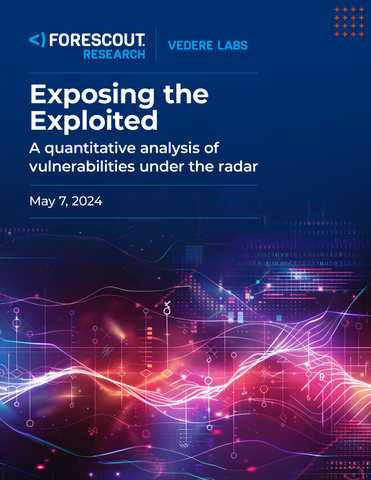RSA Conference 2024 — Forescout Technologies Inc., a global cybersecurity leader, today unveiled new research, Exposing the Exploited, an analysis uncovering a host of exploited vulnerabilities not captured by the CISA KEV catalog, the most popular source of information on vulnerabilities known to be actively exploited by threat actors. Exposing the Exploited details how an over-reliance on legacy information databases and standard guidance drastically underrepresents the global threat landscape. The study was conducted by Forescout Research – Vedere Labs, a leading global team dedicated to uncovering vulnerabilities in and threats to critical infrastructure.
This press release features multimedia. View the full release here: https://www.businesswire.com/news/home/20240507143608/en/

Forescout Research - Exposing the Exploited (Graphic: Business Wire)
“Vulnerabilities are being found, weaponized, and exploited in the wild faster than ever before, with 97 0-days exploited in 2023 and already 27 this year,” said Elisa Costante, VP of Research, Forescout Research – Vedere Labs. “Current methodologies for cataloging issues such as MITRE’s Common Vulnerabilities and Exposures (CVE) system and NIST’s National Vulnerability Database (NVD) are critical tools but have significant limitations. This research shows that even FIRST’s Common Vulnerability Scoring System (CVSS), the Exploit Prediction Scoring System (EPSS) and CISA's Known Exploited Vulnerabilities (KEV) should not be used exclusively.”
Read the blog: Exposing the Exploited: Analyzing vulnerabilities that live in the wild
Forescout researchers found a significant increase in unrecognized exploited vulnerabilities in the wild with no CVE identifiers and CVSS scores. The top findings include:
- Vulnerabilities without a CVE are growing. Forescout recently found 90,000 vulnerabilities without a CVE ID and this number is increasing every year. 44% of the vulnerabilities without a CVE ID can be used to gain access to a system and 37% have either high or critical severity.
- No database captured everything. 2,087 distinct exploited vulnerabilities were identified across four databases, but no database alone contained all the information. CISA-KEV had 1,055 (50%) of the total exploited vulnerabilities. 968 exploited vulnerabilities (47%) are seen in only one database and only 90 (4%) are seen in all four.
- Customer networks showed thousands of affected devices. The devices were affected by 28 vulnerabilities in our catalog (VL-KEV) and were not tracked by the CISA KEV list. Most of these devices were uninterruptible power supplies (UPSs), computers, printers, infusion pumps, and network equipment.
- Most exploited vulnerabilities had either high (44%) or critical (39%) severity. The most common root causes of exploited vulnerabilities were OS command injections, path traversals, improper input validation and out-of-bounds write.
- The most common targets were web applications, operating systems and routers. OT and IoT devices were the fifth most common target. The most exploited OT and IoT devices were Network Attached Storage (NAS), IP cameras, building automation devices, and VoIP equipment.
The rapid increase in vulnerabilities being discovered and exploited by malicious actors underscores the need for a new approach to prioritization. While the CISA KEV list is a valuable resource and the most recognized catalog for exploited vulnerabilities, it does have certain limitations. Our analysis reveals that the CISA KEV catalog is not exhaustive — we have observed exploited vulnerabilities in the wild that are absent from this catalog. Additionally, crucial details on how these vulnerabilities are exploited, such as modus operandi, tactics, techniques, and procedures (TTPs), and associated indicators of compromise (IoCs), are often missing. Therefore, organizations should rely on multiple sources to enhance their preparedness.
Forescout released Exposing the Exploited from RSA Conference 2024 where its researchers can discuss these findings in the North Hall 5353, May 6-9.
How Forescout Research Works
Forescout Research employs its Adversary Engagement Environment (AEE) to conduct analysis, leveraging a blend of real and simulated connected devices. This dynamic environment functions as a robust tool, enabling the pinpointing of incidents and the identification of intricate threat actor patterns at a granular level. The overarching objective is to elevate responses to complex critical infrastructure attacks by leveraging the detailed insights and understanding derived from this specialized deception environment. The AEE is maintained by Vedere Labs, a leading global team dedicated to uncovering vulnerabilities in and threats to critical infrastructure. Forescout products directly leverage this research, which is also shared openly with vendors, agencies, and other researchers.
About Forescout
The Forescout cybersecurity platform provides complete asset intelligence and control across IT, OT, and IoT environments. For more than 20 years, Fortune 100 organizations, government agencies, and large enterprises have trusted Forescout as their foundation to manage cyber risk, ensure compliance, and mitigate threats. With seamless context sharing and workflow orchestration across more than 100 full-featured security and IT product integrations, Forescout makes every cybersecurity investment more effective.
Forescout Research – Vedere Labs is the industry leader in device intelligence, curating unique and proprietary threat intelligence that powers Forescout’s platform.
View source version on businesswire.com: https://www.businesswire.com/news/home/20240507143608/en/
Media Contact:
James Kenny
RH Strategic for Forescout
forescoutpr@rhstrategic.com
Carmen Harris
carmen.harris@forescout.com
